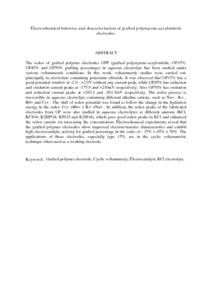Citation
Radhi, Muhammed Mizher and Tan, Wee Tee and Haider, Adawiya J.
(2013)
Electrochemical behavior and characterization of grafted
polystyrene-acrylonitrile electrodes.
International Journal of Electrochemical Science, 8 (9).
pp. 11416-11428.
ISSN 1452-3981
Abstract
The redox of grafted polymer electrodes GPE (grafted polystyrene-acrylonitrile, GP15%, GP45% and
GP50% grafting percentage) in aqueous electrolyte has been studied under various voltammetric
conditions. In this work, voltammetric studies were carried out, principally in electrolyte containing
potassium chloride. It was observed that GP15% has a good potential window at -2.0 - +2.0V without
any current peak, while GP45% has reduction and oxidation current peaks at -175.9 and +210mV
respectively. Also GP50% has oxidation and reduction current peaks at +263.1 and -261.9mV
respectively. The redox process is irreversible in aqueous electrolyte containing different alkaline
cations, such as Na+
, K+
, Rb+
and Cs+
. The shift of redox potential was found to follow the change in
the hydration energy in the order: Cs+ >Rb+ > K+
>Na+
. In addition, the redox peaks of the fabricated
electrodes from GP were also studied in aqueous electrolytes at different anaions (KCl, KClO4,
K2HPO4, KNO3 and K2SO4), which gave good redox peaks in KCl and enhanced the redox current via
increasing the concentration. Electrochemical experiments reveal that the grafted polymer electrodes
show improved electron-transfer characteristics and exhibit high electrocatalytic activity for grafted
percentage in the order of : 15% > 45% > 50%. The applications of these electrodes, especially type
15%, are in the cyclic voltammetric technique when used as a working electrode.
Download File
![[img]](http://psasir.upm.edu.my/29979/1.hassmallThumbnailVersion/Electrochemical%20behavior%20and%20characterization%20of%20grafted%20polystyrene.pdf)  Preview |
|
PDF (Abstract)
Electrochemical behavior and characterization of grafted polystyrene.pdf
Download (84kB)
| Preview
|
|
Additional Metadata
Actions (login required)
 |
View Item |

